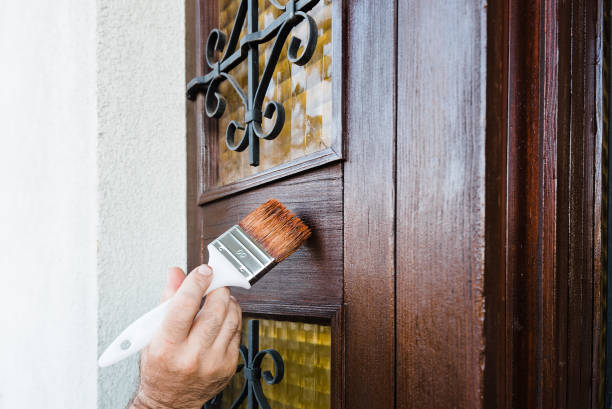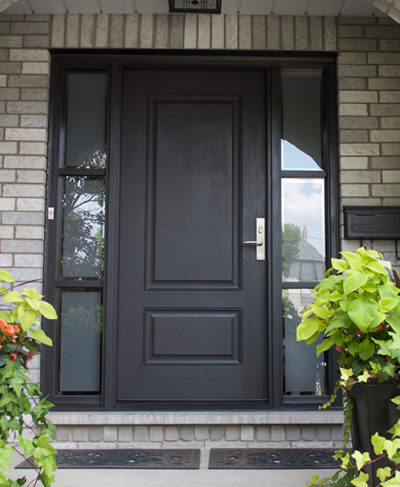A fiberglass door is a popular option for many homeowners due to its durability and low maintenance. However, after years of exposure to the elements, a fiberglass door may start to look worn or dull.
If you’re looking to spruce up your fiberglass door, refinishing it is an easy and affordable way to give it new life. Here’s how you can refinish a fiberglass door in just four steps.
Why do You need To Refinish A Fiberglass Door?
Refinishing a fiberglass door is an important project to consider if you want to protect and enhance the surface of your entryway. Not only does it help to keep dirt and debris from collecting on the door, but it also adds an extra layer of protection from inclement weather.
In addition, many finishes for fiberglass doors come in a variety of styles, colors, and levels of gloss. This gives you more freedom when designing the entrance of your home.
By refinishing your fiberglass door, you can enjoy an attractive look for years to come without worrying about its lasting durability.
Refinishing A Fiberglass Door
Step 1: Gather Your Supplies
Before you begin the refinishing process, it’s important that you have all the materials you need on hand. You’ll need a power sander, sandpaper (100-120 grit), painter’s tape, drop cloths, paintbrush or roller (depending on the size of surface area), exterior primer and paint, and mineral spirits/turpentine.
Make sure that all your supplies are in good condition before beginning this project.
Step 2: Prep the Surface
Once your supplies are gathered together, open your doors and windows for ventilation purposes and lay down dropcloth(s). Next, use the power sander with 100-120 grit sandpaper to remove any loose material from the surface of your door.
Once this is complete, use painter’s tape to cover any areas of your door that should not be painted (i.e., window frames or hardware). This will ensure that these areas remain untouched during the painting process.
Step 3: Prime & Paint

Once the surface has been prepped for painting, it’s time to apply primer. For best results apply two coats of exterior grade primer with an outdoor-rated paint brush or roller making sure each coat has had ample time to dry between applications (approximately 2 hours).
After priming is complete apply two coats of exterior grade paint allowing each coat ample time to dry between applications as well (again approximately 2 hours).
Wait at least 24 hours before closing/using your newly refinished fiberglass door(s) so that they can fully cure.
Priming vs Staining
Refinishing a fiberglass door can be a daunting task, but once you understand the steps involved it becomes far less intimidating. An important part of the refinishing process involves priming and staining the surface of your door.
Priming refers to the application of a specialized coating that creates an ideal surface for subsequent layers of paint or stain to be added. Staining, on the other hand, is a chemical process that alters the color, shade, and texture of the material being treated.
Essentially it imbues your fiberglass door with an organic look without having to use actual wood grains or colors.
So before you start tackling any fiberglass project, make sure you have understood what both priming and staining involve in order to achieve optimum results.
Step 4: Clean Up & Admire Your Work
After the final coat of paint is dry it’s time for clean up! Dispose of used sandpaper properly then wipe down surfaces with mineral spirits/turpentine if necessary. Then step back and admire your beautiful new fiberglass doors!
Related Topic: How To Restain A Wood Door Without Stripping?
Do you need to strip the fiberglass door before restaining?
Stripping the fiberglass door before restaining is recommended as it helps to prevent the staining from looking uneven. Stripping removes any existing dirt, grime, and old finishes that may be present. Without stripping, these elements can affect the color of your new stain.
To strip a fiberglass door, start by sanding lightly with 120-grit sandpaper to create a smooth surface. Then apply a chemical stripper evenly over the entire surface and wait 10 minutes for it to break down the old finish.
Once completed, wipe away all of the chemical stripper residues with a damp cloth and let them dry completely before you start staining.
How To Strip A Fiberglass Door?
Stripping a fiberglass door can seem intimidating at first, but if done correctly it is relatively straightforward. Keep in mind there will be a few fumes from the stripping process, so make sure to do the job in an open space or with adequate ventilation.
First, remove any hardware and use a heat gun to soften any paint or varnish. Once softened, use a scraper and steel wool to begin lifting earlier layers of finish.
Lastly, you’ll want to hand-sand the entire surface with 220-grit sandpaper prior to painting. Taking your time during each step of the process is paramount for getting that perfect stripper job on your fiberglass door!
Conclusion
Refinishing a fiberglass door is a great way to give it new life without spending too much money or time on the project! With some simple supplies from your local hardware store and our four-step guide, you can transform old drab fiberglass doors into something amazing in no time at all!
So put on some safety glasses and get started today!
Related Topic: How To Cover Glass Front Door For Privacy? 7 Ways
FAQs
Is it better to stain or paint a fiberglass door?
When making the decision to either stain or paint a fiberglass door, there are a few factors that should be taken into consideration. Paint is typically an easier and less expensive application than traditional wood staining, often requiring minimal prep work and fewer coats.
However, if you’re looking for a natural wood finish with rich tones and variation, then staining might be your best bet. Of course, it will require more time and effort in order to achieve the desired outcome.
Depending on your project goals and budget constraints, both staining and painting can be viable options for a fiberglass door it just comes down to finding the approach that works best for you.
Can you use wiping stains on the fiberglass door?
Wiping stain is an excellent product to use if you’re looking to update the look of your fiberglass door. Its easy application makes it perfect for those who have never stained before, and its streak-free finish helps enhance the texture and grain of the door.
Wiping stain can be applied with a soft cotton cloth or brush, giving you the freedom to customize your staining process. Keep in mind that a less vigorous application may result in a lighter finish, so make sure you practice on a sample area to achieve your desired results!
Can all fiberglass doors be stained?
Many fiberglass doors are designed to be stainable, allowing homeowners to customize the look of this hardwearing entrance to their home. The staining process begins by sanding down the door to create a smooth and even surface that can absorb large amounts of the stain without causing any drip marks.
If doors have any seals or other elements that need protection from the staining material, these items must also be covered with masking tape before application begins. In order for the stain to truly last, all steps must be completed correctly and an additional layer of sealer should be added.
With adequate prep work, you can customize your fiberglass door with eye-catching multi-dimensional wood grain effects.
How do you fix a faded fiberglass door?
Reviving a faded and dull fiberglass door can be done with a few simple steps. To get started, the door surface should be thoroughly cleaned to remove any dirt or debris. Next, use a mild household cleaner mixed with warm water to scrub away any build-up of scum and dirt on the glass.
To bring life back into the fibers, use a sponge with a bit of rubbing alcohol or vinegar to rub lightly in circular motions until the color of the fiberglass begins to fade evenly.
Lastly, add a top coat of sealer to give it an extra layer of protection against future fading or discoloration. With these steps in mind, you can easily revive your fiberglass door and enjoy its bright appearance for years to come.
